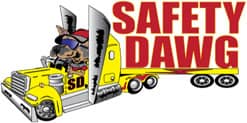As a professional driver you have been trained to avoid collisions! You don’t tailgate and you travel slightly below the flow of traffic. You are a cautious and safe driver. But the unthinkable still happens. You are involved in a crash!
The crash is not your fault and it wasn’t even preventable. (Yes, there is a difference between “fault” and “preventability”.) Now as a professional driver, what do you do?
At the scene of a crash, the first step is to turn on your four-way or emergency flashers. You want to warn others about the crash scene so that they might avoid becoming involved.
The second thing to do is to turn off the engine of your truck. This is of course, to prevent fires. You have not yet gotten out of the cab of the truck to assess the damage. You don’t know yet if you’re leaking fluids that may be ignited or if another vehicle is leaking gasoline. But turn off the engine of your truck right away. In most cases, you do not want to move your vehicle until the police arrive. That being said, if it’s a minor crash in a major metropolitan city you may be required to move your vehicle because you have to go to the accident reporting center.
Assuming that you are not moving your truck, the next thing to do is to set out your warning devices, whether they are triangles or flares. You are trying to protect the scene of the crash as well as protect yourself and anyone else involved in the crash. You are also trying to warn other motorists about a crash scene so they do not get involved.
Now that you have protected the scene it is time to assess damages. The first types of damage you want to know about are personal injuries. If someone has minor injuries at the scene of the crash, use your common sense and the first aid kit in your truck and render assistance. If someone has serious injuries do not move the person unless their life is in danger! Again, you can assist the injured but do not move them unless his or her life is in danger.
Now it’s time to call the police and report the collision. After the police are notified it is time to get in touch with your company. If your phone is not working then give the necessary information to a passerby and asked them to make the two phone calls. Remember that you are to stay at the scene until the police arrive. Always remain polite and courteous to everyone, even the person that caused the crash.
You may speak to the police and your company’s insurance representatives but never speak to the media. When you are giving your verbal statement to officials, try to make sure, if possible that you are not overheard and always tell the truth. Never admit guilt or apologize!
Now it’s time for you to document the scene and to take photographs.
Most of us have cameras on our cell phones. When you take photos, be sure to take pictures of the license plates of the vehicles involved in the crash. You will also want to photograph the accident scene. Take lots of photographs. Take photographs from all angles including a 360° circle. The photographs should be both from near and far. You will also want to photograph any evidence such as skid marks. Try to include stationary objects in some of your photographs. This will help in the future if an investigator has to return to the scene of the crash as they now have a fixed object to relate the photographs to. Never take pictures of seriously injured people. Leave that to the police and the insurance companies.
If your crash is of the catastrophic or very serious nature, and includes serious injuries or fatalities, you do not need to photograph the scene. Your insurance company and the police will send out professionals to record the crash.
There you have it. What to do at the scene of the crash even when it’s not your fault. Drive safe and I hope you never have to use these tips!
